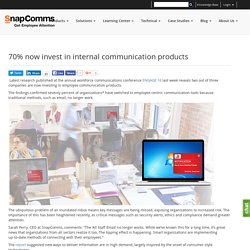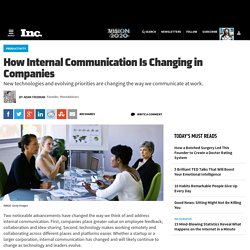

How Mobile Is Your Corporate Communication? Corporate communication has come a long way from stiff press releases and business brochures, full of business lingo which very little of the general public could understand.

As the trend for transparency and personal communication between businesses and potential customers increased, so did the availability of media and technologies to make this communication possible at all levels. Living in a Mobile World Currently, the greatest territory open for exploration for PR managers, CSR departments and communication specialists is the mobile environment.
Mobile phones have become a staple in our daily lives, either as professionals or private individuals. There are more business deals and financial transactions performed on mobile phones than by any other means. For this reason, the question asked in the title is legitimate: how mobile is your corporate communication?
Understanding the Customers’ Expectations What about Your Employees and Business Partners? Can You Afford to Be Left Behind? CCOs Prioritizing Digital Communications. More than seven in 10 global chief communications officers report that digital communications ranks as their top priority for the next 18 months, according to The Rising CCO VI, a survey conducted by executive search firm Spencer Stuart and Weber Shandwick.

CCOs in every region also report that digital and social media would be their closest working partners in the future. This aligns with a related trend of using data analytics widely to evaluate corporate reputation, refine messaging, and identify company supporters and allies, according to the study. The importance of employee communications as a top tier priority differs regionally among global CCOs, who say they plan to make hires in the employee engagement and internal communications field in the next 12 to 18 months. 70% now invest in internal communication products. Latest research published at the annual workforce communications conference ENGAGE 16 last week reveals two out of three companies are now investing in employee communication products.

The findings confirmed seventy percent of organizations* have switched to employee-centric communication tools because traditional methods, such as email, no longer work. The ubiquitous problem of an inundated inbox means key messages are being missed, exposing organizations to increased risk. The importance of this has been heightened recently, as critical messages such as security alerts, ethics and compliance demand greater attention.
Sarah Perry, CEO at SnapComms, comments: “The ‘All Staff Email’ no longer works. While we’ve known this for a long time, it’s great news that organizations from all sectors realize it too. The report suggested new ways to deliver information are in high demand, largely inspired by the onset of consumer-style technologies. What can internal comms learn from consumer journalism? The rise of broadband, smartphones and social media has changed the way that we consume news outside of work.

Yet often, internal communications seems stuck in the dark ages of bland newsletters and email marketing that doesn’t quite hit the mark. Our attention span is the shortest it has ever been – at just eight seconds – we dual screen more than ever before, and we’re likely to stop reading an article after 15 seconds.
Err, you're still with me, yes? Consumer journalism has changed rapidly to keep up with this new world we live in: embracing mobile apps, video, and social media. But some, such as Buzzfeed, have shaken up the market completely. Too much information, too little communication. How many times have you heard someone complain that they’re drowning in information?

My clients regularly talk about how many emails they have to read through each day before they can get on with their ‘real work’. We live in an age where we are bombarded with information day in, day out. In larger organisations the problems are even more profound. Internal communications on noticeboards, intranets, in newsletters and emails all compete for our attention. To bot or not to bot: Understanding A.I.'s role in the enterprise. Over the past few months, the internet has been buzzing about bots.

Microsoft, Facebook and other major players are opening up their A.I. platforms for developers, and these toolkits are an exciting and important step towards democratizing access to A.I. For the enterprise, however, the bot frenzy has accelerated a challenge that executives have been facing for the past couple of years. Many enterprise companies understand that they need an A.I. strategy and that the technology will be deployed throughout their business.
Yet the challenge for them is where to actually begin. Transformational tech. How To Use Technology To Enhance Internal Communication. Your organization has two key strengths that form its pillars – the products/services it offers and the people it employs.

Both are pivotal for its success. Your organization’s external brand is heavily reliant on the strength of its internal brand. Top three Internal Comms Trends 2016. Traditional vs Digital Communication Channels. I recently read a great article that discussed balancing efficiency and the human touch.

The article, by Alex Blyth, drew attention to an important decision that businesses face in marketing and customer service – whether to use traditional or digital channels (or the right mix of both) for communication with existing and prospective customers. Traditional channels (e.g. phone and face-to-face) are often seen as labour intensive. Future of internal communication. Internal communication has changed beyond all recognition in the past two decades.

Peter Doherty founded Headlines with a mission to make internal comms more relevant and effective. As the agency celebrates 20 years of challenging convention, he offers a candid commentary on how our profession has transformed – and where it is going next. The android voice of Stephen Hawking eloquently expressed the power of communication: “For millions of years mankind lived just like the animals. Then something happened which unleashed the power of our imagination. “We learned to talk and we learned to listen.
“Speech has allowed the communication of ideas, enabling human beings to work together to build the impossible. Inspired by this light-bulb synopsis, 20 years ago Headlines was born. How Internal Communication Is Changing in Companies. Two noticeable advancements have changed the way we think of and address internal communication.

First, companies place greater value on employee feedback, collaboration and idea-sharing. Second, technology makes working remotely and collaborating across different places and platforms easier. Internal communication tips - Advanced Learning Institute. Internal communication plays a crucial role in building company culture, increasing employee engagement, and encouraging collaboration that drives business results. Yet, sometimes it is difficult to get your busy workforce to actually read internal communications and consume the information they need to be more connected to the organization and effective in their jobs.
Consider your audience (employees) and what it is you want to achieve (inform and inspire). Key Insights into Employee Communication for the Next Generation. By Vincent Gross On September 22, 2015 One of the fascinating parts of working with corporate communications projects, especially those that involve digital signage communications networks and kiosks, is the challenge of the blending content and its successful delivery through a variety of channels, which is of tremendous importance. Many of the more challenge parts of infrastructure are the simplest — for instance — ensuring that there is electrical power and web connectivity at all desired locations. Not every site is appropriate for a hard-wired installation, and yet, sometimes due to size or type of construction, wireless systems aren’t suitable either.
Occasionally there may even be issues with the ability to run electrical power to the desired area. In these cases the ability to come to a workable compromise is a key skill set between the hardware team and the internal client. I anticipate two trends to develop in the long term. The second trend I anticipate will involve kiosks.
Five groundbreaking Internal Communication innovations. If you’re bored of the same old practices and finding it tough to overcome routine thinking, you’re not alone. There are two things we want more than anything in our profession: Fresh strategic insights and creative tactics – we’re crying out loud for innovation. It’s the only way to be successful when our Internal Communication role and remit is constantly changing. New business dynamics, complex functional demands and employees with increased mobility, knowledge and influence, mean Internal Communication professionals are now connectors and facilitators who also support strategy and create content.
Not a bad thing at all, for a future of higher expectations and greater influence awaits us. You can find data, case studies and further insights to support each of these five innovations in a brand new Executive Summary. The new ‘ABCs’ of Internal Communication: How our role is changing. Much has been written about how the role of Internal Communication is changing. But what about the role of the communicator? Baker & McKenzie’s Jeff Zwier explores three emerging aspects of IC in the first blog in a series on this hot topic.
Today's internal communicators must deftly manage the intersection of high-tech and high-touch in a communications environment that is becoming increasingly global, integrated with external efforts, and steeped in more and more concepts from change management, negotiation, social psychology and political influence. Yet at the same time, they must also retain the creativity and skills to engage employees across an ever-expanding array of platforms. As a hiring manager, leader and individual contributor in a wide range of marketing and communications roles over the past 20 years, I've seen expectations of the communicator's role change from those of specialist writers to generalist business drivers. 1. Renowned global speaker, best-selling author and trainerReplay: #H2HChat: Reimagining What Employee Communication Should Be.
The “traditional workplace” as we know it has vanished. These rapid changes are fueled by new technologies. They’re fueled by the mass adoption of social channels, the ubiquity of mobile, and the connectivity to devices. Today’s workers have a digital mindset. They are digitally literate and driven to leverage new and emerging technologies to connect, inspire and innovate. But with all these rapid changes, you might be wondering, “Is your organization keeping up?
7 Facts You Did Not Know About Internal Communication. Why your approach to employee engagement may be wrong. It’s no mystery that employee engagement is low. But what’s the real reason? Could it be that we’re missing something that likely has a large impact? How SoundCloud Keeps Communication Flowing Across 4 Offices in 4 Time Zones. This is how hard building healthy internal communications is at a growing startup: SoundCloud moved its VP of Community — the man who built its 20+ team of community managers and support specialists for over 175 million unique listeners — to work on the problem full time. His name is David Noël, and he's the kind of guy who runs toward big challenges. In this case, making sure the company's 300+ employees are able to collaborate seamlessly across four global offices (Berlin, London, New York, and San Francisco) in four different time zones. This is no easy feat, and the result has been some groundbreaking thinking around culture and communication.
There hasn't been a lot written on this type of role or emphasis, making this exclusive interview with Noël a foundational document for all startups on how to build a world-class internal comms program. Here, he shares the five initiatives that have worked best for him and been vital to SoundCloud's success.
How the story of a goldfish will change internal communication. What Does Data Science Mean to Internal Communications? The Employee Communication revolution: ripping up the rule book at HSBC. How do you make 250,000 employees feel like they’ve got a seat at the table? Pierre Goad, Co-Head of Global Communications, and Emmajane Varley, Head of Employee Communications Global Banking and Markets, tell us how to get leaders to shut up and listen. The new ‘ABCs’ of Internal Communication: Connecting across and beyond the organization.
Driving change and supporting leadership in developing faster, better messaging that supports strategy execution means the modern IC professional must be networked more than ever before – both inside and outside the organization. RIP Email: What Digital Messaging Will Look Like in 2020. London Underground’s Head of Internal Communication: “Don’t get left behind in 2015!” The third Internal Communications Conference will be held in London from March 23 to March 25, 2015. Uber's approach to internal communication. The new ‘ABCs’ of Internal Communication: How our role is changing. Integration 'is future for internal comms' Companies must integrate internal communication into the “total communication picture” in the future, says a leading IC chief. Simon Sproule insists people joining today’s IC industry need a “mind shift” to understand the importance of integrating channels of communication.
Moving on up: the internal communicator as leader. Image: Thinkstock. The Future of Internal Communication Skills. 2015: The year of the organizational connector – and the future of Smarter Internal Communication. As communications explode – particularly online – employees don’t need more information. What they crave is connection. In the third in this blog series on the future of Smarter IC, we explore what being a powerful connector looks like and how you can up your game. The end of internal communication? 5 Internal Communication Trends To Watch For In 2015 and Beyond. With the world of work changing rapidly and expectations from the increasingly young workforce rising, internal communication in 2015 and beyond will never be the same. In this post I share perspectives that internal communicators must consider to stay relevant, add value and continue making an impact. Evolving asks of the internal communicator: With employees seeking information in formats of their choice (channels, on demand, BYOD among others) there is a need for the communicator to be adept with newer technologies, craft personalized content and make information accessible in ways that matter.
8 Steps to Stronger Organizational Communication. 2015: The year of possibilities – and the future of smarter Internal Communication. SME Masterclass: How to improve internal communications within your business. Improving Workplace Communication-5 Steps. "Chief Engagement Officer:” The Role of CEOs in Internal Communication - Institute for Public Relations. Taylormadeinkew.com. Why Internal Communication Matters in the Digital Age. How Crowdsourcing Can Improve Internal Communication and Teamwork. Six Internal Communication Trends for 2014 - Four Corners Communications. Where is Internal Communication headed? Politics of Employee Communication - People Development MagazinePeople Development Magazine. Are you a trendsetter? 7 trends in digital internal communication. The Second Phase of Social Business Evolution. Internal Communication in a Collaborative World - HR Schoolhouse. What’s your Internal Communication Strategy? » Inovautus Consulting.
How is Internal Communication progressing in the Digital Workplace? Filling the job openings: Employer–employee communication is vital for vibrant organization. Using Social Media to Improve IC (Internal Communication) Five groundbreaking Internal Communication innovations. Eras-of-IC-graphic.jpg (JPEG Image, 1879 × 1400 pixels) - Scaled (54%) Straight Talk: Training Leaders To Communicate In The New World. Creating a Basic Internal Communications Strategy. The Changing Role of Internal Communication. How Fast-Growing Startups Can Fix Internal Communication Before It Breaks. The State and Future of Enterprise Collaboration. The returning war for talent is driving demand for internal communications, research reveals. Two Kids Built a Minecraft Office For Their Dad's Company.
The changing strategic role of Internal Communication. The evolution of social media. The 11 vital internal communications trends you’d be crazy to ignore. Internal Communications predictions for 2014. It's time to revamp your internal communication. Internal Comms: What does 2014 have in store? Internal Communication definition. The Melcrum Blog: Predictions for the future of digital communication during 2012-2013. 11 Laws of Internal Communication – Time for a rethink? Simply-summit wrap-up. Bitrix24 Study Shows Decline of Email as Primary Tool for Internal Communications and Collaboration. Standing at the Edge: Embracing the Future of Enterprise Communications. Is this still a valid definition of internal communication?
Small Business HR: 6 Tips for Effective Employee Communication. Five Trends Tribe Predicts for 2012. INTERNAL COMMUNICATIONS: THE NEGLECTED STRATEGY? DOES YOUR ORGANISATION NEED ONE? How To Tap Into Your Best Resource For Expanding Your Company’s Social Media Reach.